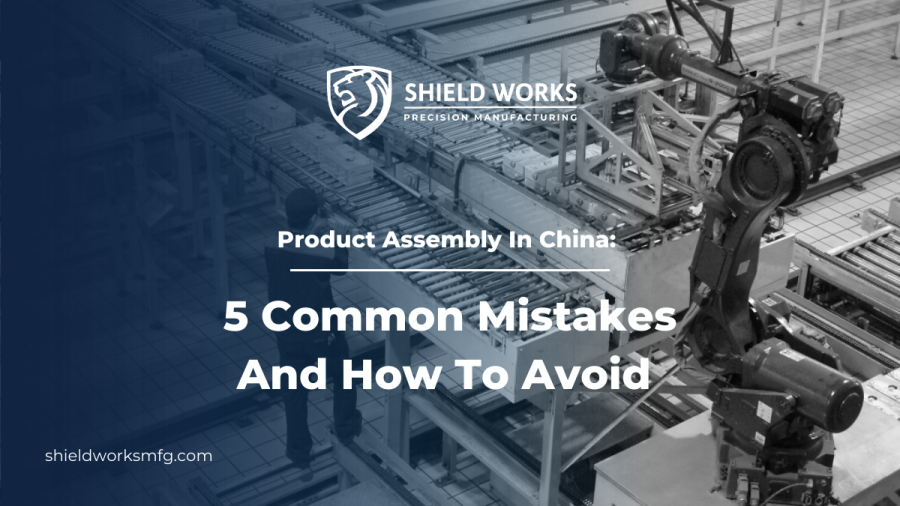Product Assembly In China: 5 Common Mistakes And How To Avoid

Today, overseas businesses of all sizes are outsourcing product assembly to Chinese companies as part of their overall outsourcing strategy.
There are many benefits to this approach, including reducing costs and improving efficiency. However, business owners should be prepared to work with Chinese suppliers who have different perspectives on product standards and quality control than what you may use before.
However, dealing with Chinese product assembly suppliers requires skills and experience. To reduce the number of assembly mistakes in your products, here are seven ways you can start reducing errors during the product assembly process.
Not Verifying The Supplier
Your customer satisfaction has a direct correlation with product quality. Yet, a lot of times companies don’t see mistakes or quality issues until it’s too late.
The biggest cause of product assembly errors is skipping over a supplier’s due diligence.
There are certain protocols every entrepreneur should follow when it comes to verifying suppliers, but one major aspect involves verifying their capabilities by checking their certifications and audit reports. Entrepreneurs should be sure they go through all available measures before accepting a quote from a prototyping manufacturer—doing so could save them from headaches down the road.
Only in this way can you confirm if your supplier owns their facilities or is a middleman.
Not Communicating Clearly
The assembly line is a huge component of manufacturing, and it’s where most errors occur.
It’s no surprise that misunderstandings often happen between Westerners and Chinese people. When you and your assembly partner aren’t on the same page, problems will undoubtedly arise.
In this case, it’s important to clarify expectations beforehand, anticipate problems before they arise, and encourage an open flow of communication so anything problematic can be taken care of sooner rather than later.
To avoid confusion, when communicating with your Chinese partner, you must be clear and concise in everything you say. You should try using brief words so that it will take less time for them to understand what you’re trying to convey.
Not Eliminate Unnecessary Processes
Although eliminating all manufacturing errors may not be a realistic option, you can eliminate non-essential processes during product assembly to reduce costs and timeframes.
This step is an easy one for some manufacturers—but for others, it’s something that must be worked toward over time.
A great way to start is by being honest with yourself about what processes are essential and which ones are not. You may be surprised by how much you can cut back without hurting quality.
Not Setting Up Sample Tests
On a product-assembly line, setting up sample tests can be run throughout each shift.
These tests can be used to test workers and catch problems before they result in big mistakes. Include enough checks and balances on each test that they’re impossible to fail without making an error.
For example, if assembly involves inserting a screw into an electrical component, include wire connectors on your sample piece so workers know what is correct for installation. If a worker tries to install it incorrectly, he or she will have to remove it and start over.
If you don’t include these extra components, there will be no way of knowing whether or not your worker did something wrong until after he or she has completed his or her work.
With sample tests, any errors will become apparent right away and can be corrected immediately—or prevented from happening at all—before they snowball into bigger issues later in production.
Not Conducting Product Inspection
As you may know, it’s impossible that there is zero defect in making and assembling the product.
And you may need to know what type of defect is in your product and how can it affect your product functionality.
By recognizing and fixing errors during assembly, you’ll maintain high product quality and reduce financial losses. The more you know, the more you can do to improve your product.
In this case, it’s a good idea to conduct an inspection to check the product quality for you. If you don’t, you’ll be accepting a level of risk that may not be necessary.
An experienced inspector can find the major defect in the product and write a detailed report, so you have no reason to worry about the customers complaining about the product quality.
The Solution For Your Assembly Project
Sometimes, finishing a product assembly project can seem like an insurmountable challenge.
If you are considering outsourcing your assembly and are unsure where to start, Shield Work is here to help you make this process easier.
We own an IP protection flagship facility to conduct activities from manufacturing, and product assembly to quality inspection and warehousing.
With our British ownership and management background, we take pride in our international experience and we know what works and what doesn’t! Contact us for a no-cost consultation!
